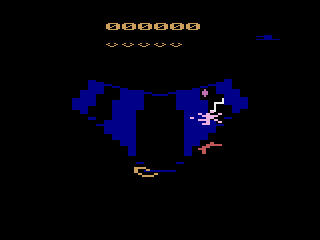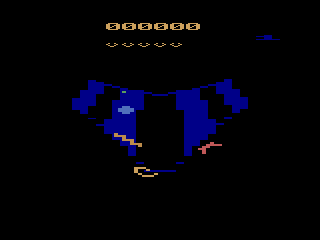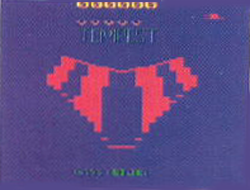|
|
Tempest
|
Name:
|
Tempest |
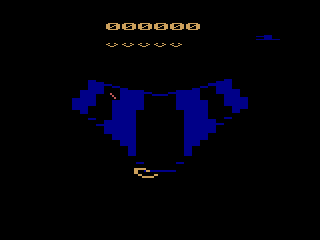 |
| Company: | Atari | |
|
Model #:
|
CX-2687 | |
|
Programmer:
|
Unknown (Programmer) & Michael Kosaka (Graphics) | |
| Year: | 1984 | |
|
Released?
|
No
|
|
|
Notes:
|
A review of this game was seen in Ultimate Gamer magazine. |
On the list of games that probably should never have been
tried on the 2600, Tempest has to be near the top. Why
Atari decided they could reproduce a 3D vector game on the 2600
is beyond me, but the results weren't pretty. Sometimes
one has to respect the limitations of the 2600.
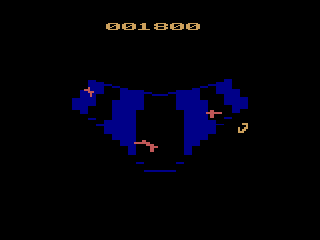
I've said it once and I'll say it again; If there's one thing the 2600 doesn't do well it's diagonals. Unfortunately Tempest is chockfull of diagonals as the tubes angle out from the center of the screen to form complex geometric patterns. This leads us to the next problem, if there's a second thing the 2600 doesn't do well it's complex geometric patterns! The 2600 version gets around this by not having 3D tubes, but rather a flat looking shape (often jokingly compared to a pair of woman's underware) with the enemies coming from one side and the player moving on the other. For some reason the board seems to flux and change a bit as things move around the screen, this is probably the result of a programming glitch. The board s segmented into what could be called tubes (if you use your imagination), but these "tubes" don't seem to correspond to where the real tubes (which are invisible) are.
This brings us to the next problem, if there's a third thing the 2600 doesn't do well and it's 3D perspective. Atari couldn't get around this one; the 3D perspective is what makes Tempest "Tempest". Atari tried to simulate this by changing the enemy's size to make it look like it was getting closer. Unfortunately there aren't nearly enough frames of animation to do this, so the enemies sort of jump forward in an awkward fashion. The enemy graphics are very blocky and becomes even more evident as the size is increased when they approach the outer edge of the tube. This combined with a very blocky looking "shape" for the board makes for one ugly looking game.
Amazingly, even with the 2600's limitations, there are four different types of enemies present in this version.
| Flippers |
|
These are the little bowtie shaped guys who are the main enemy of the game. They're not dangerous until they reach the top of the tube and start coming after you. |
| Flipper Tankers |
|
These will break into two Flippers when hit. |
| Pulsars |
|
These guys are dangerous! They will electrocute the tube they're in every now and then killing you instantly if you're on it. In this version the tube doesn't light up when electrocuted, but the Pulsar itself will glow a second before, warning you to beware. |
| Fuseballs |
|
These fun little guys are similar to Flippers but they only zip up and down the tube they're in. |
The controls in this early version are often very frustrating. There appear to be set places where your blaster can move to (hidden tubes), but they don't seem to correspond to the shape on the screen. This wouldn't be so bad if they were at regular intervals, but they seem to be very close together towards the middle of the screen and very far apart near the edges (a side effect of mirroring the playfield). This makes lining up your shots with the incoming enemies very difficult because you're not quite sure where the next "hidden tube" is. This coupled with the fact that the "jumping" enemies move very quickly up the short tubes makes for a very difficult game. The firing is a bit off as well, and it appears that your blaster will fire towards the left side of it's graphic instead of from the middle. This wouldn't be so bad if the bullets didn't have a bad habit of disappearing when too many object are on the screen (probably due to flicker), this can lead to some mysterious deaths from invisible bullets. Thankfully you have your Super Zapper in this version, which can be activated by pressing up and fire.
In the programmers defense, they did a wonderful job on Tempest considering she was attempting to do the impossible. But while a game technically can be done on the 2600, doesn't necessarily mean it should be (see Double Dragon for another example). Also, since this version isn't complete, it's really not fair to start judging it yet. Given some time, I'm sure a much more playable version with improved graphics and smother gameplay could have been put together. While it probably wouldn't have ever looked like its arcade counterpart, this prototype proves that Tempest could (in a very limited fashion) be done on the 2600. A later version with some added features like a title screen was reviewed in Ultimate Gamer magazine, but it's unknown what happened to that prototype.
The name of the programmer for the 2600 version of Tempest has been a bit of a mystery. Carla Meninsky has generally been identified as the programmer, but some other programmers seem to recall that someone else worked on Tempest. Carla herself shed some light on this when she mentioned that the prototype we have isn't her version at all. More digging shows that the current prototype (dated 1-5-84) was made long after Carla had left Atari. So it appears that Atari decided to assign another programmer to make a new version of Tempest after Carla left rather than use her existing code. Unfortunately, Carla's original version remains lost and the identity of the programmer behind this version remains a mystery.
| Version | Cart Text | Description |
| 1/5/84 | Tempest 1-5-84 | Early version |
| 2/28/84 | Tempest 2-28 | Version reviewed in Ultimate Gamer |

